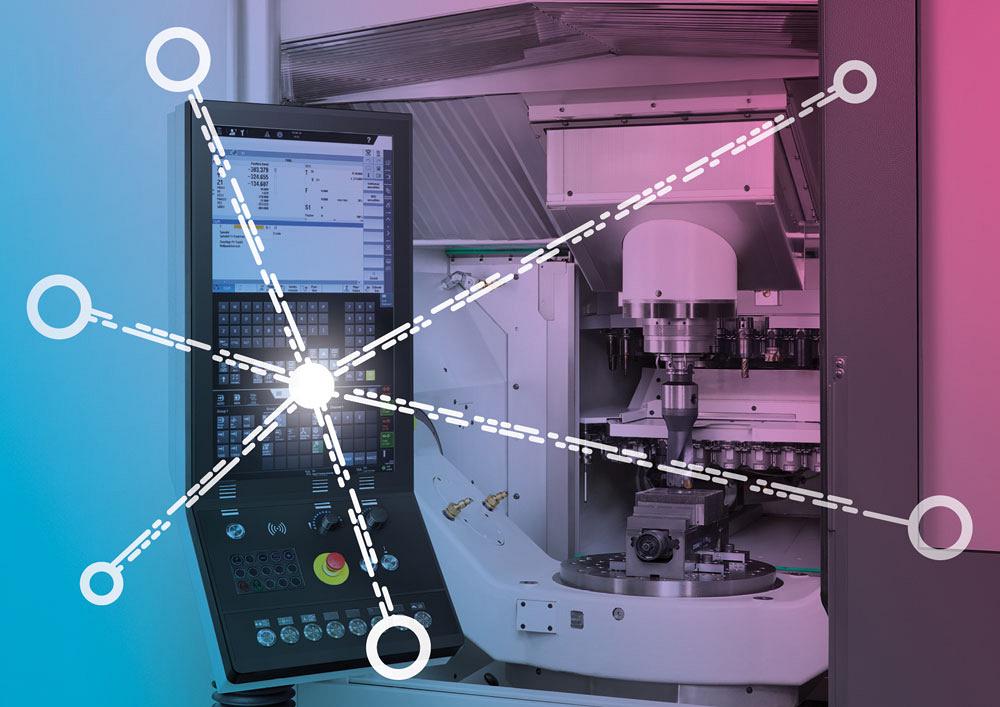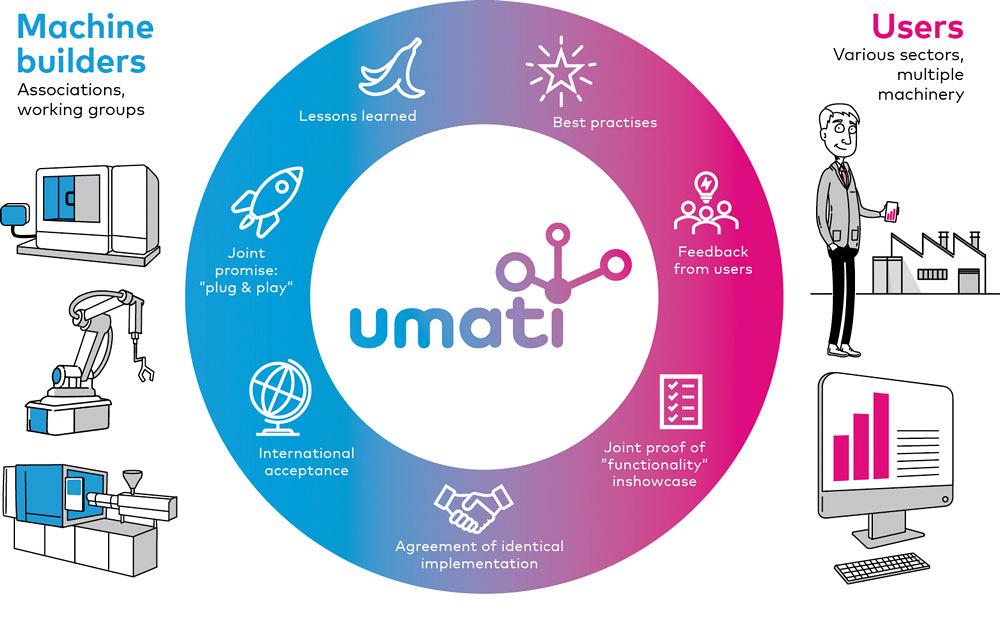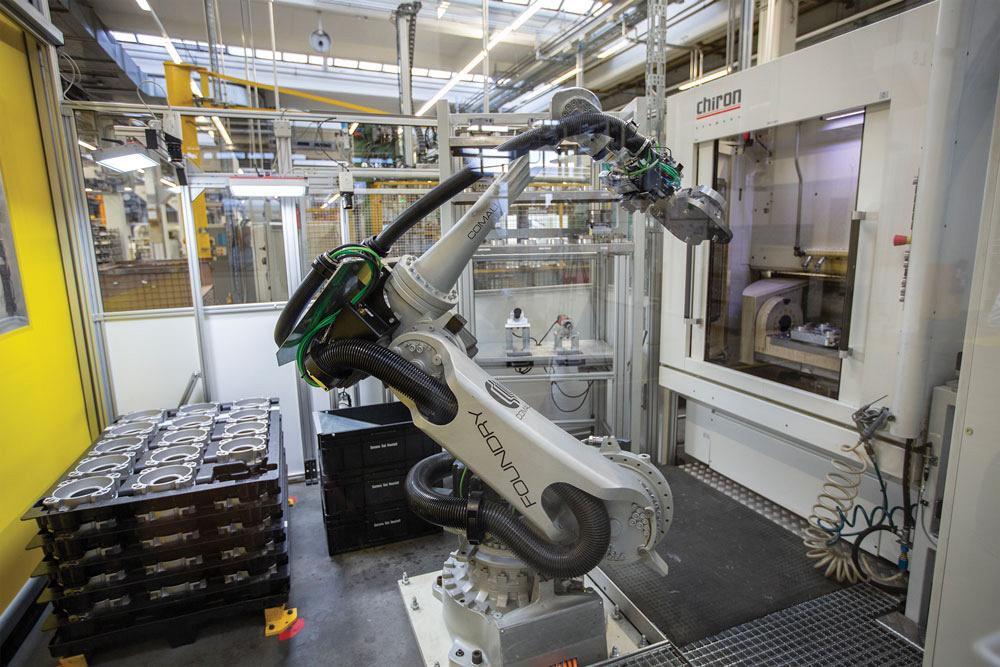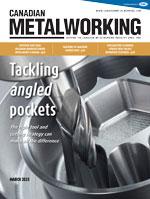Associate Editor
- FMA
- The Fabricator
- FABTECH
- Canadian Metalworking
Machine-to-machine connection
OPC UA is creating interoperability on the shop floor
- By Lindsay Luminoso
- April 10, 2023
- Article
- Automation and Software

Industry has long advocated for some sort of common communication standard between these multi-vendor installations. OPC Unified Architecture (UA) provides a global standard for controller-to-controller or machine-to-machine communications. umati (VDW)
A connected shop floor and smart technology are all the rage these days. Many machine shops are finding new ways to optimize their processes to get the most out of their machines.
Only a few years ago, machines were primarily operated and programmed by a human being. There was little if any interconnectivity between machines, nor was there any sort of supervisory system.
Today’s machines are becoming smarter and more digital interconnections are being made, which raises some questions. Specifically, what kind of method of interoperability can be implemented between machines?
Creating a Global Standard
Most machine shops don’t operate a single brand of machines—although they may have many of the same brand or type—there often is a mix, especially when it comes to automation and other ancillary equipment. This mix and proprietary technology can make interoperability problematic.
“That's where OPC UA comes in,” said Mike Clark, director, OPC Foundation North America, Scottsdale, Ariz. “It's becoming, if not already, the global standard for industrial interoperability and data information security.”
Today’s machine tool OEMs and equipment vendors are challenged with providing their customers with a way to universally configure and operate these machines.
“A shop may have up to 10 different vendors it is working with, each with its own unique type of interface, which may not be interoperable with other vendors' products,” said Clark. “A shop could have a robot from KUKA, a CNC lathe from another manufacturer, and conveyor systems from Mitsubishi; without an interoperability standard, connectivity may not be possible.”
Industry has long advocated for some sort of common communication standard between these multi-vendor installations. OPC Unified Architecture (UA), the technology from the OPC Foundation, provides a global standard for controller-to-controller or machine-to-machine communications.
A vendor can adopt the OPC standard and implement it in their product. A rigorous certification test ensures that every product is OPC UA-compatible. An OPC UA-certified product from one vendor and another OPC UA-certified product from a different vendor can seamlessly communicate with each other based on developed standardized information models.
Applying OPC UA
The main benefit of OPC UA is to standardize information model capabilities in companion specifications and to ensure equipment data structures are easily defined. The user can choose, based on the protocols available in OPC UA, suitable transport protocol and data encoding for various use cases.

Several machines with OPC UA servers using Companion Specifications endorsed by umati, implemented according to umati guidelines, are connected to one IT system with an OPC UA client. umati (VDW)
“These unified data structures or information models make it possible for information from one machine to go to some sort of supervisory system, or to another machine,” said Clark. “And those unified data structures are excellent for pulling up analytics of machine health or machine status, whether the machine is ready for its next maintenance cycle, or something of that nature. This is possible because the data structures of these information models are being shared from the machine to some sort of supervisory tool.”
Any OPC UA-certified machine needs an OPC UA server, which is a software application that has been written to one of the OPC Specifications and converts hardware communication protocol used by a PLC into the OPC protocol. The server responds to requests and provides the data to an OPC client.
OPC clients are applications that depend on data exchange with industrial systems. Common applications are visualization, supervisory control and data acquisition (SCADA) systems, or manufacturing execution systems (MES). The client can interface or request data from servers. The server contains all the metrics with values and interfaces predefined based on the OPC standard. The OPC UA server models data, information, processes, and systems as objects and presents those objects to clients in ways that are useful to various types of client applications, like MES.
“The OPC server in those devices is [loaded] with the data that it's capable of offering,” said Clark. “It’s usually far more than anybody else would need.”
It's up to the user to decide how much or how little they want to process or use the data. The data leveraged allows machine shops to dig deeper into what is going on with their machines and compare similar data points.
Leveraging Data
As technology advances and users needs change, so does the need to assess how exactly standardization is being implemented. Enter umati (universal machine technology interface), a community of stakeholders—and their customers—in the machine tool building industry that help promote and adopt open, standardized interfaces based on OPC UA.
“Umati facilitates the data exchange between machines, components, and installations, and their integration into customer and user-specific IT ecosystems that is easy, seamless, and secure,” said Götz Görisch, consultant, German Machine Tool Builders’ Association (VDW), Frankfurt am Main, Germany. “The initiative promotes companion specifications for machinery equipment to shop floor owners. A main portion of the stakeholders had to sit together to write down a standard. Success required worldwide stakeholders at the table to create the companion specification for the machine tool industry. Together we are defining something which everyone can agree on and use. The foundation is there, specifically with OPC UA for machinery, which is valid for every machine.”
One of the main advantages of working with a universal standard protocol is that users can easily tap into data regardless of the brand or machine type, as long as it is OPC UA certified.
“For example, umati interfaces provide transparency on what is happening on the machine, and with the availability of data, users can build their own dashboards or KPI graphs,” said Görisch.
The Benefits of a Common Language
With machine-to-machine language and common interface protocols, shops are able to extract data from different machine manufacturers for further processing by another system or program, like a local MES system, where it can be turned into value.

Industry has long advocated for some sort of common communication standard between these multi-vendor installations. OPC Unified Architecture (UA) provides a global standard for controller-to-controller or machine-to-machine communications. umati (VDW)
“Machine connectivity and data acquisition is probably the first step to the digitalization of machine tools,” said Gligor Ukropina, product manager—machine tools, Siemens Canada, Oakville, Ont. “Being able to access data from various machine types and different manufacturers is the first and crucial step on the shop floor. If we have a common language, there will be easier data flow across all layers of the shop floor. This data can be used to feed back into a digital twin for continuous improvement.”
Some equipment OEMs have found ways to bridge the language gap and standardize it across the board by starting with OPC UA and building programs for specific uses. Because OPC UA is a cross-platform, open standard, machine tool builders and equipment OEMs are able to develop ways to connect technologies in ways that have never been done before.
For example, getting two different pieces of equipment to connect together and operate using one language is one of the advantages of this initiative.
“Machine tools operate with G-code programming as a CNC programming language, which most operators understand and use today,” said Ukropina. “When we introduce robots for machine tools on the shop floors, we integrate the robot arm into [the] CNC and keep the same programming language and operational language for both the CNC and the robot.”
The robot can be controlled using a single point of operation—the CNC—meaning both the robot and machine tool are programmed on the same language. With this, robots can access and perform all CNC functionalities. Today’s robots positioned next to machine tools often are used for pick-and-place applications. However, with a common language and additional CNC accuracy and functionalities, robot applications can expand greatly.
“The operator is using the cycles and the same G-codes for the normal CNC machines on the robot,” said Ukropina. “Having the robots controlled by the CNC means that they can perform actual machining functions, which opens up more application use cases.”
For example, if a robot is integrated into a CNC and uses the same programming language, then it gains all of the functionalities and precision of that CNC. It is capable of processing and performing machining tasks. So rather than sitting and waiting for machine tending tasks, the robot can perform roughing operations or polishing of the part, if needed. This will increase the overall productivity of the manufacturing process significantly.
“For the most part, robots haven’t been used for machining applications because they have lacked the accuracy and rigidity,” said Ukropina. “But by integrating the robot arm, without any robot control, we can utilize all CNC functionalities like path and speed control, tool management, compensations, seamless CAD/CAM integration, and others to achieve the highest path and position accuracy of the robot. Since the mechanical robot arm is integrated into the CNC machine, a unified service concept can be applied here, as a robot is part of the machine tool.
“We are seeing this solution being adopted more and more in both the automotive, and aerospace industries, and as well in the energy sector.”
Associate Editor Lindsay Luminoso can be reached at lluminoso@canadianmetalworking.com.

Robots can be controlled using a single point of operation—the CNC—meaning both the robot and machine tool are programmed on the same language. Siemens
German Machine Tool Builders’ Association (VDW), www.vdw.de
OPC Foundation, opcfoundation.org
Siemens, siemens.com
umati, umati.org
About the Author

Lindsay Luminoso
1154 Warden Avenue
Toronto, M1R 0A1 Canada
Lindsay Luminoso, associate editor, contributes to both Canadian Metalworking and Canadian Fabricating & Welding. She worked as an associate editor/web editor, at Canadian Metalworking from 2014-2016 and was most recently an associate editor at Design Engineering.
Luminoso has a bachelor of arts from Carleton University, a bachelor of education from Ottawa University, and a graduate certificate in book, magazine, and digital publishing from Centennial College.
subscribe now


Keep up to date with the latest news, events, and technology for all things metal from our pair of monthly magazines written specifically for Canadian manufacturers!
Start Your Free Subscription- Trending Articles
Sustainability Analyzer Tool helps users measure and reduce carbon footprint

Mitutoyo updates its end-user portal

Enhance surface finish with high-speed machining

Equispheres secures $20 million investment round

Solid carbide drills produce precision holes in short chipping materials

- Industry Events
Automate 2024
- May 6 - 9, 2024
- Chicago, IL
ANCA Open House
- May 7 - 8, 2024
- Wixom, MI
17th annual Joint Open House
- May 8 - 9, 2024
- Oakville and Mississauga, ON Canada
MME Saskatoon
- May 28, 2024
- Saskatoon, SK Canada
CME's Health & Safety Symposium for Manufacturers
- May 29, 2024
- Mississauga, ON Canada















